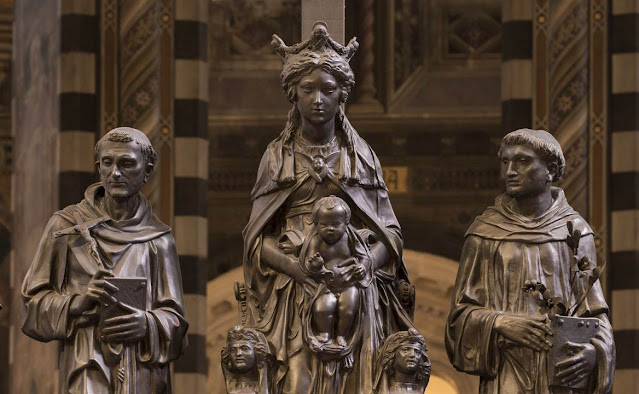Madonna and Child between St Francis and St Anthony
Madonna and Child between St. Francis and St. Anthony (1448)
Bronze, height 147, 160 and 145 cm. Basilica di Sant'Antonio, Padua
These statues were executed for the High Altar of the Basilica. The figure of the crowned Mother of God is at the center of the altar. The way she is portrayed - strictly symmetrical in composition - is to a degree borrowed from medieval models, rather unusually for Donatello. It is probably safe to assume that the clients had made their requirements known in this matter and that Donatello was making every effort to fulfil them. The two saints, Francis and Anthony, both Franciscans, are placed on either side of the Madonna.
Donatello was master of sculpture in both marble and bronze, one of the greatest of all Italian Renaissance artists. He never married and he seems to have been a man of simple tastes. Patrons often found him hard to deal with in a day when artists' working conditions were regulated by guild rules. Although he knew a number of Humanists well, the artist was not a cultured intellectual. It is not known how he began his career, but it seems likely that he learned stone carving from one of the sculptors working for the cathedral of Florence about 1400.
Donatello continued to explore the possibilities of the new technique in his marble reliefs of the 1420s and early 1430s, having also become a major sculptor in bronze.
In the early 1450s, Donatello undertook some important works for the Paduan Church of San Antonio: a splendidly expressive bronze crucifix and a new high altar, the most ambitious of its kind, unequaled in 15th-century Europe. Its richly decorated architectural framework of marble and limestone contains seven life-size bronze statues, 21 bronze reliefs of various sizes, and a large limestone relief, Entombment of Christ. The housing was destroyed a century later, and the present arrangement, dating from 1895, is wrong both aesthetically and historically. The majestic Madonna, with an austere frontal pose seemingly a conscious reference to an earlier venerated image, and the delicate, sensitive St Francis are particularly noteworthy. The finest of the reliefs are the four miracles of St Anthony, wonderfully rhythmic compositions of great narrative power. Donatello's mastery in handling large numbers of figures (one relief has more than 100) anticipates the compositional principles of the High Renaissance.
Donatello was apparently inactive during the last three years at Padua, the work for the San Antonio altar unpaid for and the Gattamelata monument not placed until 1453. He had dismissed the large force of sculptors and stone masons used on these projects. Offers of other commissions reached him from Mantua, Modena, Ferrara, and even perhaps from Naples, but nothing came of them. Clearly, Donatello was passing through a crisis that prevented him from working. He was later quoted as saying that he almost died "among those frogs in Padua".
The last years of Donatello's life were spent designing twin bronze pulpits for San Lorenzo, and, thus, again in the service of his old patrons the Medici, he died.




.jpg)
Comments
Post a Comment